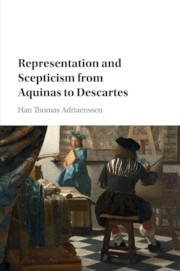PART I - THE VEIL OF SPECIES
Published online by Cambridge University Press: 13 July 2017
Summary
How do objects in external reality become cognitively present to us? To answer that question, medieval scholasticism formulated many different accounts of representation. One of these accounts had it that external objects are represented to us by means of special representational devices, called species. But although this theory had influential proponents such as Thomas Aquinas and Henry of Ghent, Franciscan philosophers in the late thirteenth and early fourteenth centuries soon made the species theory the object of critical discussion.
In these discussions, the theory was often construed as saying that species make their objects present to us by being themselves objects of apprehension. Peter Olivi, for example, did not see how species could make objects present to us without themselves being apprehended, and concluded that any philosopher who claims that species are needed to represent the world ipso facto commits herself to indirect realism. Similarly, Peter Auriol, in his treatment of representation, introduced the species theory as an answer to the question of what meets the mental eye in thought, and one of the central arguments in Ockham's discussion of species presupposes that if species represent things to us, they will do so in much the same way as statues do: by being objects of apprehension that bring to mind other objects.
But how did this construal of the species theory relate to the kind of account that we get in major proponents of species? This question will be addressed in Chapter 1, which takes a brief look at the account of species in Thomas Aquinas and Henry of Ghent. Although the point is controversial, we will see that Aquinas likely held that external objects are made present to us via the apprehension of species that represent them. A similar position was put forth by Henry. The idea that we come to the cognition of external objects in virtue of apprehending species will thus be seen to have a textual basis in at least these two proponents of the species theory.
- Type
- Chapter
- Information
- Representation and Scepticism from Aquinas to Descartes , pp. 11 - 12Publisher: Cambridge University PressPrint publication year: 2017



